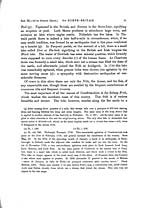Volume 5
(56) Page 50
Download files
Individual page:
Thumbnail gallery: Grid view | List view

50 Dryfesdale parish, and various other hills, deserve notice for the remains of British hill-forts on their summits. In the lower part of this shire, along the Solway, there are several heights, which would not merit this appellation if they did not rise from a level country. Annan-hill, near the influx of Annan river with the Solway, rises 256 feet above the level of the adjacent frith. The eminence whereon stands the Tower of Repentance, is 350 feet above the same level. Wardlaw-hill, Caerlaverock parish, is remarkable for the British and Roman warlike works, which gave and received strength from its acclivity, and is supposed to be the Uxellum, a town of the Selgovse which is mentioned both by Ptolomy and by Richard. The hills through- out Dumfries-shire are mostly green, from their herbage of a better or worse quality, though heath sometimes does deform "the grassy-turf ;" but in general they ornament the landscape, and furnish numerous flocks; with salutary pasturage. The heights upon Moffat water, in the upper division of Annandale, and the hills upon Scar water in Nithsdale, exhibit the most remarkable precipices. Glenquhargen-Craig, in Penpont parish, is a tremendous precipice, which rises almost perpendicular to the height of a thousand feet, with two faces, exhibiting a whinstone of a brownish colour. Such then are the Alpine ridges of Dumfries-shire, which at once disfigure and ornament this picturesque district! Of Lakes, there are none in Dumfries-shire of any great extent amidst all those mountains. In the vicinity of Lochmaben, indeed, there is a cluster of six lochs, whereof the largest is the Castle-loch; being rather more than three miles in circumference, and abounding with fish of a peculiar kind (n). It was on a peninsula which projects into the southern side of this loch where Lochmaben castle was built during feudal times. A small stream carries off the superfluous waters of Lochmaben into the Annan, which discharges its collected waters into the Solway Frith. In the vicinity of the Castle-loch there are five lesser lakes, of various sizes and different shapes (o). At the source of Moffat water, embosomed among hills, there is a remarkable lake, called Loch-SJcene, which is 1300 feet above the sea- level. This Celtic name alludes to the stream which issues from this loch, and forms a tremendous cataract, that is popularly called The Gray Mare's (n) Stat. Acco., vii. 236. (o) In Dryfesdale parish there is Turnmoor-loch, which, though little more than half-a-mile in cir- cumference, sends out a stream of such strength as to drive the two mills of Turnmoor. In a morass within the same parish, there is a small lake which is called the Cauldron-loch, and which, from its great depth, never freezes. Ib. ix. 423. The Cauldron-loch was formed by the old course of the Dryfe.
Set display mode to:
![]() Universal Viewer |
Universal Viewer | ![]() Mirador |
Large image | Transcription
Mirador |
Large image | Transcription
Images and transcriptions on this page, including medium image downloads, may be used under the Creative Commons Attribution 4.0 International Licence unless otherwise stated. ![]()
| Caledonia, or, An account, historical and topographic of North Britain from the most ancient to the present times > Volume 5 > (56) Page 50 |
|---|
| Permanent URL | https://digital.nls.uk/74530236 |
|---|---|
| Description | Vol. V. |
|---|---|
| Attribution and copyright: |
|

